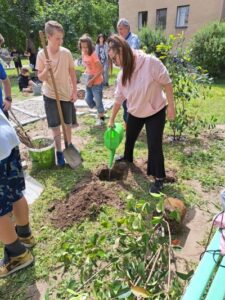Základná škola, Školská ul. 10, Zemianska Olča, Slovakia
This project includes 3 smaller service learning projects that were implemented: 2021 Climate alley, 2022 Dignity, 2023 Green amphitheater. Pupils map their surroundings, talk to parents, grandparents, residents, they notice shortcomings or places that ask for change and this is the reason why these projects rise. The first project Climate Alley – abandoned and neglected space in the village, through which elderly people and children pass. The space got a new look and also a new function – it serves the general public. The pupils modified an abandoned passageway in the village, in which they planted bushes, trees, and flowers, and placed benches and information boards about life on Rye Island years ago, about native animal species and their activities. The alley has become a relaxing learning zone, connecting the path from the school to the retirement club. The second project Dignity project – after mapping the residents’ needs, the pupils discovered that at the time of frequent COVID-19 deaths, many elderly people could not participate in funeral ceremonies, as they could not stand during the ceremony. There were no benches in the cemetery. The pupils discovered that the social facilities are also in a very bad condition. The pupils managed to place 12 benches, painted the toilet, and helped procure containers for sorted waste. The third project Green Amphitheater – in the space between the schools, old trees were cut down and an empty place remained, where they planned to build a parking lot for parents. For several weeks, the pupils mapped the existing nearby parking areas and created statistics, which they evaluated with the result that the school does not need additional parking spaces. Instead of the concreted area, they proposed to build a Green mini-amphitheater – an outdoor teaching space – a shelter, a sensory path, restoration of greenery. The school received funding from the Foundation for the construction of the shelter. Some parents contributed to the acquisition of seedlings. During the projects, the pupils felt that they were an important part of creation and change.
Pupils participated in all activities from mapping needs, planning, and implementing activities to the final celebration. The pupils always first mapped the needs in the communication and set a goal, then started planning the activities together with the teacher. They volunteered to participate in activities outside of school, along with their parents and community members. The pupils specifically planted trees and did garden work, prepared descriptive tables, painted baskets for separate collections, built benches, collected money for the purchase of materials, and others.




